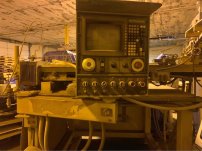I have no idea about recent changes to either but, are you considering your first waterjet or is this a replacement? I used to think waterjets were cool and then a buddy bought a big Omax. He's had it maybe ten years now. If I didn't have at least two hours of good paying work for it, every single day, I don't think I would put up with the hassles of owning one. Filthy, noisy machines. Sand everywhere and on everything. Have to shovel out and pay to dispose of tons of wet sand, the water problems, rust and erosion with the grates, etc, etc.
It's a big power consumer and--at least in Los Angeles County--the power company does industrial power billing partly on the power you could consume in a given day. So they count every big draw like welders, the water jet, big compressors, etc. and bill you whether you actually use all of them at the same time or not. That thing costs the electric bill even if it's sitting there, powered off and doing nothing.



